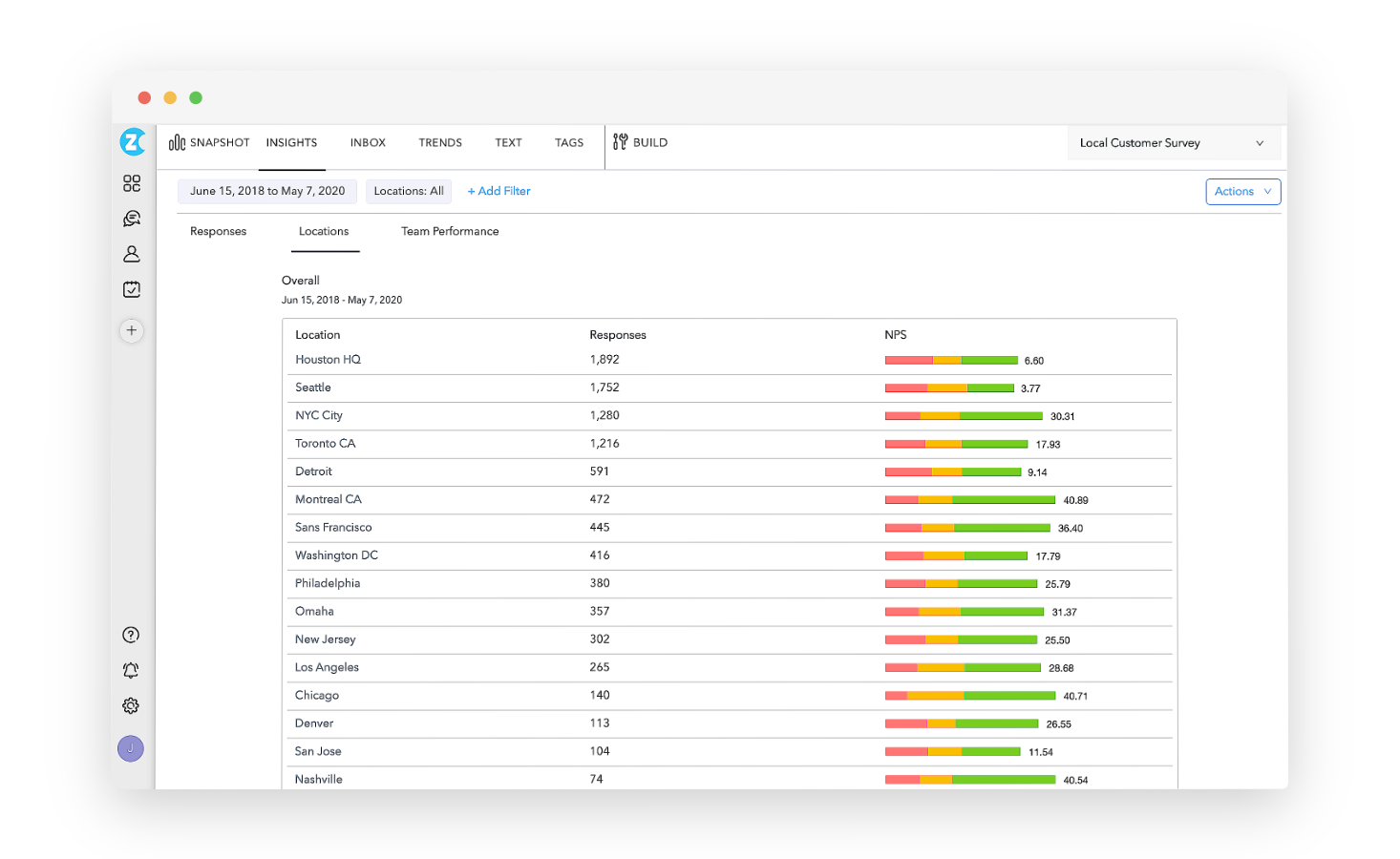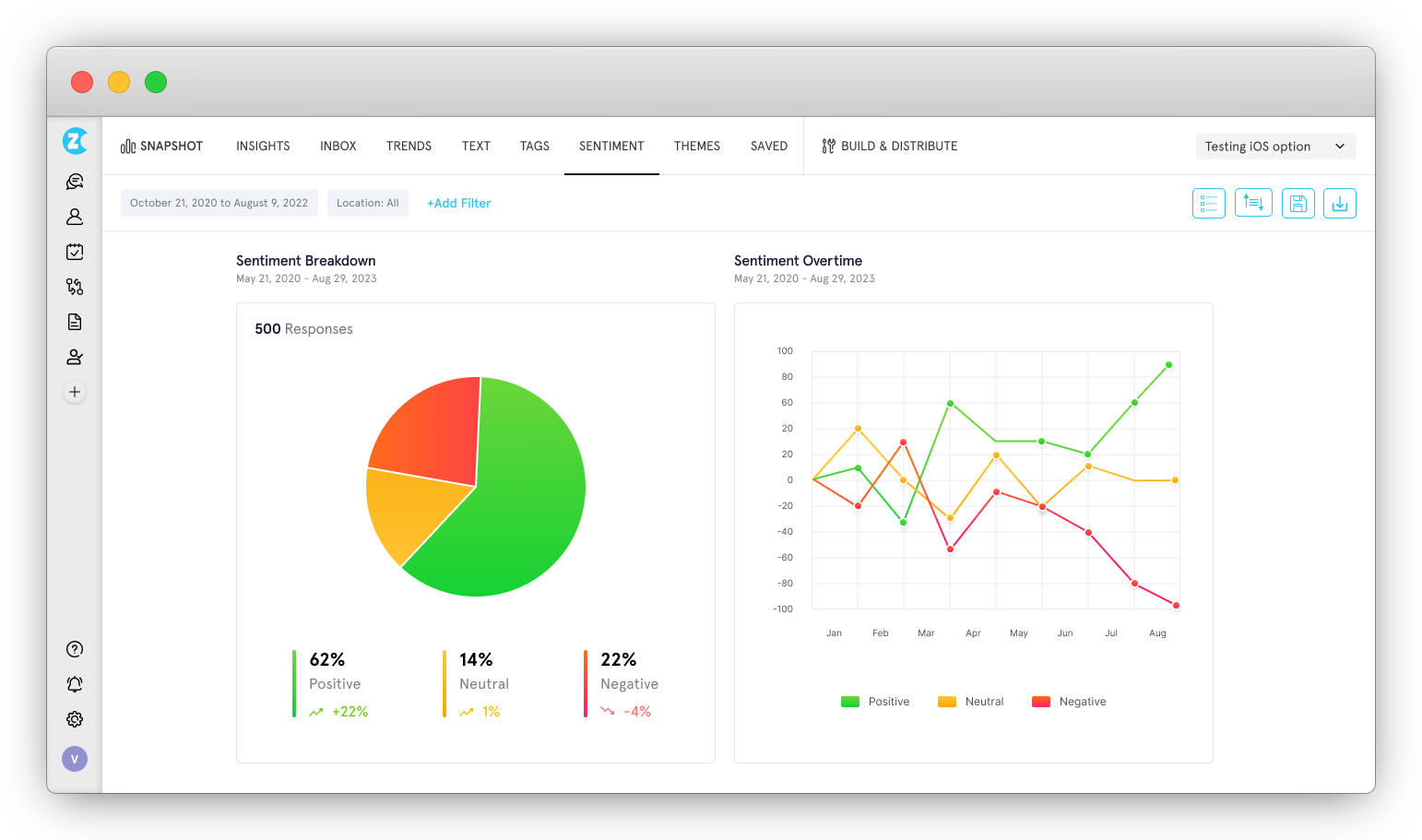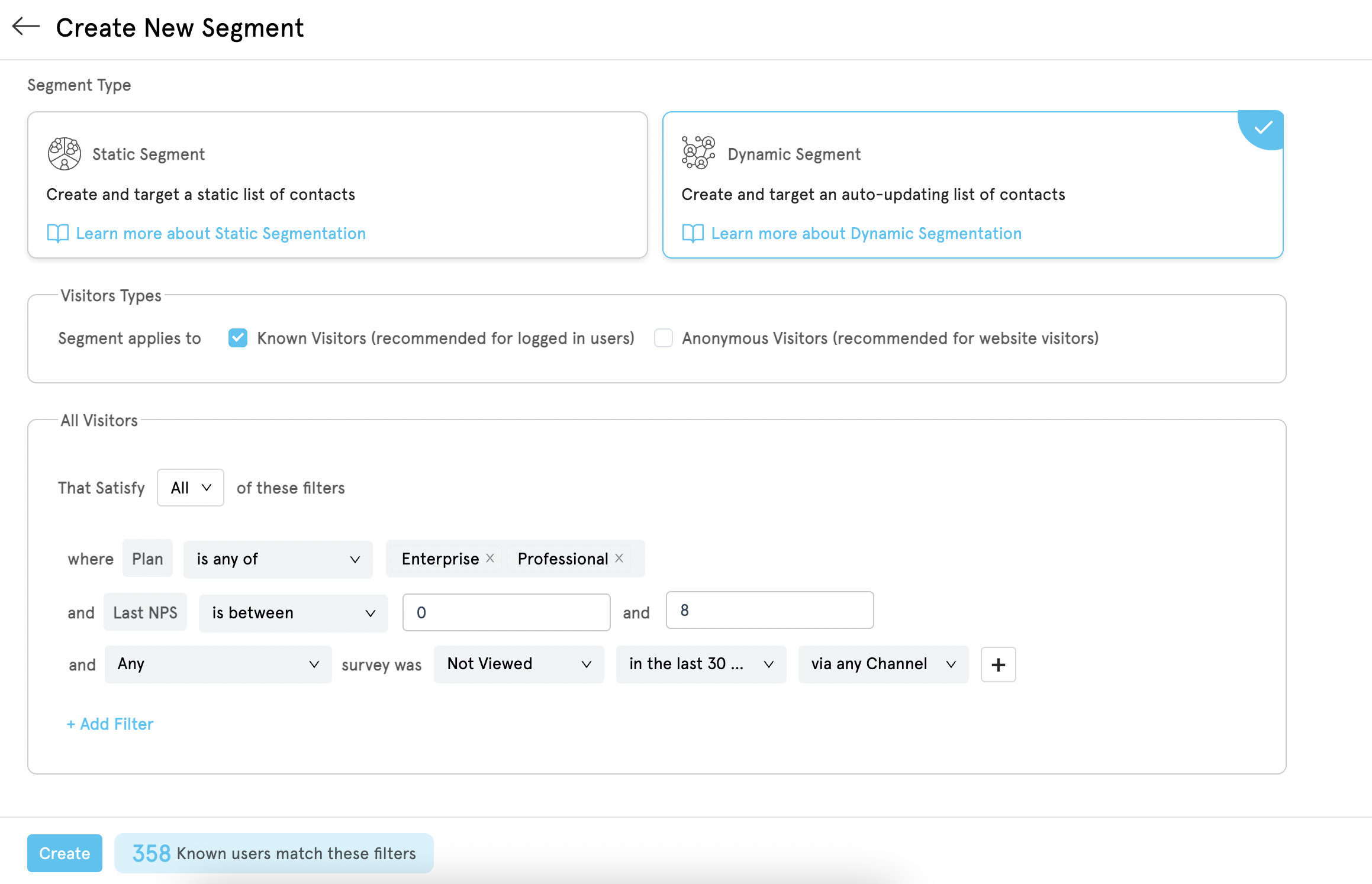An overall high NPS score can be deceiving!
It's like looking at a seemingly healthy patient with a hidden ailment. Beneath the surface, specific departments, locations, or product lines might be struggling.
For instance, a hotel with a high overall NPS might have exceptional dining but subpar room service. Or, a tech company might boast a strong NPS but discover that a particular software module is causing customer frustration.
This is where the magic of NPS segmentation unfolds!
By dividing your customer base into smaller, more manageable groups, you can uncover these hidden truths and take targeted actions to elevate overall customer satisfaction.
In this article, we will explore the importance of NPS customer segmentation, how to effectively segment your customers, and provide industry-specific examples to illustrate its impact.
TL;DR
-
NPS customer segmentation is about dividing your customer base into smaller groups to understand them better. It helps you identify strengths, weaknesses, and tailor strategies.
-
You can segment customers by demographics, behavior, revenue, product usage, and customer lifecycle stages to create more targeted strategies.
-
By applying NPS segmentation in various industries like SaaS, banking, healthcare, hospitality, and retail, you caan identify specific areas for improvement and tailor experiences.
-
You can use advanced techniques on NPS segmented data like sentiment analysis to understand emotional drivers and predictive analytics to forecast customer behavior and take proactive actions.
-
Zonka Feedback is a powerful NPS survey tool that helps you segment your customer base, customize NPS surveys, utilize powerful reporting and analytics, analyze results with AI-powered sentiment analysis, and automate NPS actions. Schedule a demo or sign up for a free trial to get started with segmenting your NPS data and close the feedback loop!
Measure Customer Loyalty with NPS ❤️
Share NPS surveys with customer segments, measure customer loyalty, and close the feedback loop with Zonka Feedback.

What is NPS Customer Segmentation?
Imagine your customer base as a bustling metropolis. Everyone lives there, but they have distinct neighborhoods, lifestyles, and preferences. NPS customer segmentation is like creating a detailed map of this city, pinpointing specific neighborhoods to understand their needs better. Instead of treating all your customers as one homogenous group, you divide them into segments based on shared characteristics.
Segmentation is about dividing a broad market into subgroups of consumers with common needs and priorities, and then designing and implementing strategies to target them.
The segments in Net Promoter Score are typically divided into NPS promoters, passives and detractors but you can go a step further and divide them based on different aspects demographics, behavior and more.
By segmenting your NPS data, you create more granular views of your customer base. For instance, instead of a single, overarching NPS score, you can explore the NPS scores of different customer segments. This allows you to identify areas of strength and weakness within specific groups.
Why to Segment Your Customers?
Segmentation is your key to unlocking the true potential of your NPS data. Here's why:
-
Identify your superfans: Discover which customer segments are your most enthusiastic promoters. These are the people who love your brand and are eager to spread the word. By understanding what makes them tick, you can replicate this success with other segments.
-
Uncover hidden Detractors: Sometimes, a high overall Net Promoter Score can mask pockets of dissatisfaction. By segmenting your data, you can identify those segments with lower NPS scores and pinpoint the root causes of their discontent.
-
Create targeted Marketing Campaigns: Segmenting customers allows for the creation of highly targeted marketing campaigns. For example, Promoters can be targeted with referral programs to leverage their loyalty, while Detractors might receive personalized recovery campaigns to address their concerns.
-
Improve Product Development: Customer feedback from different segments can guide product development. Promoters can provide insights on what’s working well, while Detractors can highlight areas needing improvement.
-
Optimize Resource Allocation: Not all customers are created equal. By focusing your efforts on high-value segments, you can maximize your ROI and achieve better business outcomes.
-
Measure the Impact of Initiatives: Want to know if your latest marketing campaign resonated with your target audience? Segment your NPS data to see if the campaign influenced NPS scores within that specific group.
How to Segment NPS Customers?
Dividing your customers into the classic NPS buckets of NPS detractors, passives, and promoters is a good start, but it's just the tip of the iceberg. To truly unlock the potential of your NPS data, you need to dive deeper. Let's explore some effective segmentation strategies.
1. Segmentation Based on Customer Characteristics
When you segment customers based on their characteristics, you uncover distinct customer personas by grouping them according to factors like demographics, revenue and more. This enables you to identify specific needs tailor products, marketing messages, and customer experiences to resonate with each group. Here’s how to segment your customers based on shared characteristics:
-
Revenue: Segmenting customers based on revenue tiers can help you understand the loyalty drivers for high-value customers. By analyzing NPS scores across different revenue segments, you can identify areas where your high-value customers are experiencing issues and take proactive measures to address them. This can be particularly useful in industries such as SaaS, where retaining high-value customers is critical to business growth.
-
Product and Service Plans: Another effective way to segment customers is by the specific products or services they use. This helps identify areas for improvement within specific offerings. For example, in the SaaS industry, you can segment customers based on their subscription plans (free vs. paid) to understand how different features impact satisfaction and loyalty.
-
Customer Personas and Cohorts: Grouping customers based on demographics, needs, and behaviors allows you to understand the NPS of distinct customer profiles. Creating customer personas and cohorts helps you tailor your strategies to meet the unique needs of each group. This approach is particularly useful in industries like retail and hospitality, where customer preferences can vary widely.
-
Customer Lifecycle: Analyzing NPS across different stages of the customer journey (acquisition, onboarding, active use) helps identify areas for improvement at each touchpoint. By understanding how customer sentiment changes throughout their journey, you can implement targeted interventions to enhance their experience at critical stages.

2. Segmentation Based on Timing
When you segment your customers based on NPS survey timing, you are essentially capturing a snapshot of their sentiment at a specific point in their customer journey. This allows you to identify trends, pinpoint areas of improvement, and tailor your interventions to maximize their impact. Here’s how you can do it:
a. Segment Before Sending NPS Surveys
By segmenting your customer base before sending out NPS surveys, you can create more relevant and engaging questions. This increases response rates and provides more actionable insights. Understanding your customer segments helps you focus on specific areas for improvement, leading to more effective resource allocation. You can do this by:
-
Identifying Key Segments: Before sending out NPS surveys, it is important to identify key customer segments. This can be done based on criteria such as demographics, purchase history, interaction channels, and more. By understanding who your customers are and what they need, you can tailor your surveys to gather relevant feedback.
-
Customizing Surveys: Once you have identified key segments, customize your NPS surveys to ensure relevance and higher response rates. Tailoring survey questions to address specific pain points and preferences of each segment will provide more actionable insights.

b. Segment After Receiving NPS Responses
Analyzing NPS data after collection allows you to identify specific customer segments driving your overall score. By drilling down into the data, you can discover opportunities to improve customer satisfaction and loyalty within these segments. This data-driven approach helps you prioritize improvement initiatives and measure their impact accurately.
-
Analyzing NPS Results by Segments: After receiving NPS responses, analyze the data to identify trends and insights specific to each segment. Are your enterprise customers more satisfied than your SMB clients? What about customers who purchased in the last quarter versus those who've been with you for years?
-
Using Segmentation for Targeted Actions: With segmented NPS data, you can create targeted improvement plans and follow-up actions. Addressing the specific needs and concerns of each segment ensures that your efforts are more impactful and result in higher customer satisfaction.
-
Analyze Verbatim Feedback: Analyzing open-ended comments within each segment helps understand the "why" behind the NPS score. This qualitative data provides valuable context and insights into the reasons behind customer sentiment. Perhaps your SMB customers are frustrated by onboarding, while enterprise clients crave more advanced features.
-
Identify Common Themes: Group similar feedback within segments to identify recurring pain points and improvement opportunities. By recognizing common themes, you can prioritize actions that will have the greatest positive impact on customer satisfaction.
-
Combine NPS Score with Behavioral Data: For a deeper understanding of customer sentiment, combine NPS scores with behavioral data such as purchase history, support interactions, and more. This holistic approach provides a comprehensive view of the customer experience. For example, you might discover that high-value customers who frequently contact support are more likely to be detractors. This points to a potential service gap.
3. Location-Based Segmentation
Location-based segmentation is your GPS for navigating the complexities of a diverse customer base. It involves dividing your customer base into groups based on their geographic location. Think cities, states, countries, or even specific neighborhoods. This approach is particularly useful for businesses with multiple locations, such as retail chains and banks.
Why does it matter?
-
Regional Preferences: People in different areas have varying tastes, needs, and preferences. What works in urban areas might fall flat in rural ones.
-
Competitive Landscape: Local competitors and market conditions can significantly impact customer satisfaction.
-
Operational Challenges: Issues like supply chain disruptions or staffing shortages can affect different regions differently.
-
Economic Factors: Regional economic conditions can influence customer spending habits and loyalty.
By analyzing NPS scores across different locations, you can uncover valuable insights into regional strengths and weaknesses. For example, a high NPS score in one region might indicate successful marketing campaigns or exceptional customer service. Conversely, a low score in another region could signal operational issues or unmet customer needs.

4. Segmentation Based on Touchpoints
Your customer journey is a series of touchpoints – moments where they interact with your brand. From initial contact to post-purchase support, each touchpoint shapes their perception of your business. By segmenting customers based on these touchpoints, you can gain invaluable insights into their experience.
Here’s how you can segment based on touchpoint and enhance your NPS strategy:
-
Transactional NPS Surveys: Deploy NPS surveys immediately after key transactions or interactions. This gives you real-time feedback on specific touchpoints.
-
Identify High-Performing Touchpoints: Are there particular interactions that consistently garner high NPS scores? Delve deeper into customer feedback to understand why these touchpoints are so successful.
-
Tailored Strategies: Create targeted marketing and service strategies for each high-performing touchpoint. For instance, if customers rave about your onboarding process, expand on the elements that make it successful.
-
Cross-Functional Collaboration: Break down silos and encourage collaboration between departments to address customer pain points.
-
Empower Frontline Teams: Share NPS data with customer-facing teams so they can directly address issues. Equip them with the tools and information to improve the customer experience.
Industry-Specific NPS Segmentation Examples
Let us look at some industry-specific NPS segmentation examples that can help you uncover hidden patterns, prioritize improvement areas, and tailor your NPS strategy for maximum impact.
1. SaaS
The SaaS industry is a battleground for customer retention. With fierce competition and rapidly evolving customer expectations, understanding your users at a granular level is paramount. NPS segmentation, when applied strategically, can be your secret weapon. Here’s how:
a. Customer Lifecycle Segmentation
Every SaaS customer follows a lifecycle: from trial to adoption, expansion, and, unfortunately, sometimes churn. Segmenting your customers based on this lifecycle reveals critical insights.
-
Trial Users: Are they converting to paying customers? If not, why? Low NPS scores among trial users might indicate friction in the onboarding process or a mismatch between product features and perceived value.
-
Active Users: Are they expanding their usage? High NPS scores among active users often correlate with product-market fit. However, a dip in NPS might signal feature fatigue or emerging competitive threats.
-
Churned Users: Understanding why customers churn is crucial. Segmenting churned users by their NPS score can reveal patterns. For instance, detractors who churn might have experienced critical service failures, while passives might have found a more compelling offer elsewhere.
b. Free vs. Paid Plans
The freemium model is a cornerstone of many SaaS businesses. However, converting free users to paying customers is a challenge. But NPS segmentation can help. Understanding the NPS of free users versus paying customers can reveal potential upsell opportunities and areas where the free plan may fall short.
-
Promoter Potential: Are your free users raving about your product? If so, they're ripe for conversion. Nurture these promoters with exclusive offers or early access to premium features.
-
Detractor Dangers: Low NPS among free users is a red flag. They might be encountering roadblocks or finding limited value. Address these issues to prevent churn before it happens.
c. Feature Usage
Your SaaS product likely offers a plethora of features. But which ones are driving customer satisfaction? Segmenting customers based on the usage of specific features can help you identify which features drive satisfaction or dissatisfaction.
-
Core Feature Focus: Segment customers based on their primary feature usage. Are users of your core feature more likely to be promoters? If not, it might be time to revisit that feature's value proposition.
-
Add-on Insights: Understand the impact of add-on features on customer satisfaction. Are customers who use premium add-ons more likely to renew? If so, consider bundling these features or creating more compelling upgrade paths.
Real Life Example
HubSpot, a leading provider of inbound marketing, sales, and customer service software, utilized NPS segmentation to better understand its customer base. By segmenting NPS data based on different customer personas, such as small businesses, mid-market companies, and enterprises, HubSpot identified distinct needs and pain points for each group.
They tailored their product features, support, and training resources accordingly. For example, enterprise clients received more personalized onboarding and dedicated account managers, which led to an increase in their satisfaction scores. As a result, HubSpot saw a notable improvement in their overall NPS, enhancing customer loyalty and retention.
2. Banking
The banking world is a complex ecosystem, teeming with diverse customers who have unique expectations and needs. A one-size-fits-all approach to customer satisfaction simply won't cut it. Just like a skilled botanist categorizes plants to understand their growth patterns, banks must segment their customers to cultivate loyalty. You can do this by performing:
a. Departmental Segmentation
Banks are complex organizations with multiple touchpoints. Understanding how different departments impact the overall customer experience is key.
-
Customer Service Spotlight: Is your banking call center delivering exceptional service? You should segment customers by interaction channel (phone, online, branch) to identify pain points. For instance, customers who prefer phone support might have different needs than those who use online banking.
-
Loan Services Satisfaction: Are your loan processes smooth and efficient? You should segment customers by loan type (mortgage, auto, personal) to uncover specific challenges. For example, customers with mortgage loans might have different expectations than those with personal loans.
-
Branch Performance: If you have physical branches, segment customers by location to identify performance gaps. Are urban branches outperforming rural ones? What factors contribute to these differences?
b. Customer Demographics
Understanding your customers on a personal level is essential for building strong relationships. Here’s how you can divide your customers into different segments based on demographics:
-
Age: Different age groups have varying expectations and preferences. For example, younger customers might prioritize digital experiences, while older customers might prefer personal interactions.
-
Income: High-net-worth customers often have unique needs and expectations. Segmenting by income level can help you tailor your offerings accordingly.
-
Product Portfolio Insights: Analyze NPS scores by product type (checking accounts, savings accounts, credit cards) to identify which products are driving customer satisfaction. This information can be used to optimize product offerings and cross-selling opportunities.
Real Life Example
Bank of America segmented its NPS data by different customer service departments such as retail banking, credit cards, and mortgage services. This detailed segmentation allowed the bank to pinpoint specific issues in each area.
For instance, they discovered that credit card customers were facing challenges with their rewards program. By revamping the program and improving customer service, they addressed these concerns, leading to an increase in NPS scores for that segment. Overall, this approach helped Bank of America to enhance customer experience across all departments.
3. Healthcare
The healthcare landscape is complex, with a myriad of patients, services, and touchpoints. To deliver truly patient-centric care, healthcare organizations must gain a deep understanding of their patients' experiences. By dividing patients into specific groups, you can identify areas of strength and weakness, tailor services, and ultimately enhance patient satisfaction.
Let's explore how to leverage NPS segmentation to create a healthier bottom line.
a. Service Line Segmentation
Hospitals and healthcare providers offer a wide range of services, from routine check-ups to complex surgeries. Segmenting patients by service line provides valuable insights into specific areas for improvement.
For example, a hospital discovered that their outpatient services had lower NPS scores due to long wait times and administrative inefficiencies. By implementing an online appointment scheduling system and streamlining administrative processes, they reduced wait times by 25%, significantly improving patient satisfaction.
Here are some categories in which you can segment your patients to deliver patient care effectively:
-
Outpatient Odyssey: Patients visiting for outpatient procedures have different expectations than those admitted for inpatient care. Understanding the nuances of these experiences can help identify bottlenecks and enhance patient satisfaction.
-
Emergency Room Efficiency: The ER is a high-stress environment. Segmenting patients by triage level (critical, urgent, minor) can help identify areas where patient flow and care can be improved.
-
Surgical Success: Segmenting patients by surgical procedure can uncover variations in patient satisfaction. For example, patients undergoing elective procedures might have different expectations than those facing emergency surgeries.
b. Geographic Segmentation
Geographic segmentation allows healthcare providers to address location-specific issues. Different regions may have varying levels of access to healthcare services, cultural expectations, and healthcare needs.
For instance, when a national healthcare chain used geographic segmentation to identify that patients in rural areas had lower NPS scores due to limited access to specialized care, they responded by introducing telemedicine services, which increased access to specialists and improved NPS scores in these regions by 30%.
Here’s how you can segment your patients into geographic segments:
-
Urban vs. Rural: Patients in urban areas might have different access to care compared to those in rural communities. Understanding these differences is crucial for tailoring services accordingly.
-
Local Competition: Analyzing NPS scores by location can help identify areas where your facility faces stiff competition. By understanding the factors driving patient satisfaction at competing facilities, you can develop strategies to gain a competitive edge.
c. Patient Demographics
Patient demographics play a significant role in shaping healthcare experiences. Segmenting patients by demographics such as age, location, or medical condition helps personalize the patient experience and improve NPS for specific groups. You can divide your patients by:
-
Age: Different age groups have unique healthcare needs. For example, elderly patients might require more attention to mobility and chronic disease management, while younger patients might prioritize convenience and digital services.
-
Condition-Specific Insights: Segmenting patients by medical condition can help identify treatment gaps and improve care outcomes. For instance, patients with diabetes might have specific needs related to medication management and education.
d. Departmental NPS
Understanding how different departments within your healthcare organization impact patient satisfaction is crucial for overall improvement. By tracking NPS scores for specific departments like emergency rooms, primary care, and specialty care, you can identify areas needing improvement.
For example, a primary care clinic found that patient satisfaction varied widely between different doctors. They used NPS data to identify top-performing physicians and shared best practices across the team. This initiative led to a more consistent patient experience and a 10% increase in overall NPS scores.
Real Life Example
Kaiser Permanente, a large healthcare organization, segmented its NPS data by various service lines, including emergency care, outpatient services, and specialized treatment centers. They found that outpatient services had lower satisfaction scores due to long wait times and scheduling difficulties.
By implementing an online appointment booking system and increasing staff for outpatient care, Kaiser Permanente significantly improved patient satisfaction and increased their NPS. This segmentation approach allowed them to make targeted improvements, leading to better patient experiences across all service lines.
4. Hospitality
In the hospitality industry, customer satisfaction can vary significantly across different experiences and seasons. The industry thrives on delivering exceptional guest experiences. By segmenting NPS data, you can uncover specific insights that help improve guest experiences and address unique challenges.
Here are some key segmentation types:
a. Experience Type Segmentation
Every guest interaction is a touchpoint that shapes their overall experience. Segmenting NPS data by experience type provides valuable insights into specific areas of strength and weakness. You can segment based on:
-
In-store Experience: Analyze NPS for physical stores to identify factors impacting customer satisfaction, such as product availability, staff friendliness, and store ambiance. For instance, a high-end fashion retailer might discover that customers are dissatisfied with the wait times during peak hours, prompting them to implement a queue management system.
-
Dining Experience: Evaluate the dining experience, including food quality, service, and atmosphere. A luxury hotel chain might find that while guests are satisfied with the food quality, they feel the service is inconsistent, leading to targeted training initiatives for waitstaff.
-
Online Experience: Assess the performance of your online platforms, focusing on website usability, mobile app functionality, and booking process. A hotel chain struggling with online booking cancellations might analyze NPS data to identify pain points in the booking process and implement changes to reduce cancellations.
b. Seasonal Segmentation
Seasonal segmentation helps address fluctuations in customer satisfaction during peak and off-peak periods. Understanding these variations can help you prepare better for high-demand seasons and maintain consistent service quality.
-
Peak Season Insights: Analyze NPS data during peak periods (holidays, summer) to understand how to manage increased demand and maintain high service standards. For example, a beach resort might experience a surge in guest complaints about overcrowding during peak season, leading to initiatives to manage guest expectations and optimize staffing.
-
Off-Peak Opportunities: Identify areas for improvement during slower periods to enhance the overall guest experience. For instance, a ski resort might offer discounted rates and special packages during the off-peak season to attract guests and gather feedback on new offerings.
You should always keep potential seasonal fluctuations in NPS in mind. For instance, it might happen that your NPS score can spike during holiday seasons due to festive decorations and special events. However, scores can also dip during business travel seasons. By introducing business-friendly amenities and services, you can balance satisfaction levels and maintain high NPS scores year-round.
Real Life Example
Marriott International used NPS segmentation to analyze feedback from guests across different hotel brands and locations. They found that certain properties had lower NPS scores due to issues like room cleanliness and staff responsiveness.
Marriott addressed these issues by enhancing housekeeping protocols and providing additional training for staff. They also used segmented feedback to improve specific aspects of the guest experience, such as dining and event services. This focused approach led to a marked improvement in guest satisfaction and an overall increase in NPS for the company.
5. Retail
With consumers having more choices than ever before, retaining and growing your customer base hinges on delivering exceptional experiences. In retail, understanding why people buy (or don't buy) is the key to unlocking growth. With NPS segmentation, you can delve into customer behavior, helping you identify opportunities to enhance the shopping experience and drive loyalty. You can segment your customers based on:
a. Product Category Segmentation
Different product categories often attract different customer segments with varying expectations. By analyzing NPS data by product category, retailers can identify which products are driving customer satisfaction and which ones require improvement.
-
Fashion Focus: Understanding NPS for clothing, accessories, and footwear can reveal trends in customer preferences and identify popular product lines. For instance, a high NPS for accessories might indicate a successful product line, while a low NPS for footwear could signal issues with sizing or comfort.
-
Electronics Edge: Analyzing NPS for electronics and appliances can highlight customer satisfaction levels with different product categories and inform inventory decisions. A retailer might find that customers are highly satisfied with their smartphone purchases but less so with their laptop options, leading to adjustments in product offerings.
-
Grocery Gains: Segmenting NPS by grocery departments (produce, dairy, meat) can help optimize product assortment and identify areas for improvement. A supermarket chain might discover that customers are particularly satisfied with the fresh produce selection but have concerns about the quality of certain meat products.
b. Store Location Segmentation
Location significantly influences customer behavior and satisfaction. By analyzing NPS data by store location, as a retailer, you can uncover regional differences and tailor your offerings accordingly. You can categorize based on:
-
Urban vs. Suburban: Compare NPS scores between urban and suburban stores to identify location-specific challenges and opportunities. For example, a fashion retailer might find that customers in urban stores prioritize trendy styles, while suburban customers prefer classic and comfortable clothing.
-
Store Format Analysis: Analyze NPS for different store formats (flagship stores, outlets, convenience stores) to optimize store experiences. A department store chain might discover that flagship stores have higher NPS scores due to superior customer service and product assortment, prompting them to replicate these elements in other store formats.
-
Foot Traffic Impact: Correlate NPS scores with store foot traffic to understand the relationship between customer volume and satisfaction. A retailer might find that stores with high foot traffic but low NPS scores are struggling with overcrowding or long wait times, prompting them to implement queue management systems or additional staff.
c. Shopping Experience Segmentation
Understanding how customers interact with your brand is essential for improving the overall shopping experience. Segmenting NPS data by shopping experience provides valuable insights.
-
In-store Satisfaction: Analyze NPS for in-store purchases to identify factors impacting customer satisfaction, such as product availability, staff friendliness, and store ambiance. A department store could find that customers are satisfied with product selection but frustrated by long checkout lines, leading to the implementation of self-checkout kiosks.
-
Online Experience: Evaluate the performance of your e-commerce platform by analyzing NPS for online purchases. Focus on website usability, checkout process, and delivery experience. An online retailer might discover that customers are satisfied with the website's design but frustrated by slow delivery times, prompting improvements in the shipping process.
-
Omnichannel Insights: Compare NPS scores for customers who use multiple channels (online, in-store, mobile) to identify opportunities for seamless integration. A retailer offering both online and in-store shopping might find that customers who use both channels have higher overall satisfaction, indicating the importance of a consistent customer experience.
Real Life Example
Sephora, a global beauty retailer, segmented its NPS data by product categories and store locations. They discovered that customers were more satisfied with their skincare products than with makeup, and that certain store locations had lower scores due to inconsistent customer service.
By addressing these issues with targeted training for store staff and enhancing the makeup product line, Sephora improved customer satisfaction. They also used segmented feedback to personalize marketing campaigns and product recommendations, leading to higher customer loyalty and increased NPS.
NPS Segmentation Beyond the Basics
As companies strive to harness the full potential of their NPS data, moving beyond basic segmentation techniques can uncover deeper insights and drive more impactful actions. Here are innovative strategies for advanced NPS segmentation that can significantly benefit your business organization.
Sentiment Analysis
Sentiment analysis goes beyond merely categorizing customers into promoters, passives, and detractors. By analyzing the emotional tone of open-ended questions within each segment, you can gain a more nuanced understanding of customer sentiments.
Here’s how you can leverage sentiment analysis:
-
Emotional Drivers Identification: Identify specific emotional drivers that affect customer satisfaction and loyalty. For example, understanding that detractors often use words like "frustrated" or "disappointed" can help pinpoint areas needing immediate attention.
-
Thematic Insights: Group similar sentiments to uncover common themes. For instance, if multiple customers mention “slow service” in a negative tone, it highlights a critical area for process improvement.
-
Real-Time Monitoring: Use sentiment analysis tools to monitor customer feedback in real-time, allowing for swift responses to emerging issues. This proactive approach can help mitigate potential churn by addressing problems before they escalate.

Predictive Analytics
Predictive analytics can transform NPS data segmentation into a powerful tool for forecasting customer behavior. By identifying patterns and trends within segmented data, you can make informed decisions and strategize effectively. Here are some advanced applications of predictive analytics:
-
Churn Prediction: Analyze historical NPS data and customer behaviors to predict which customers are at risk of churning. Early identification allows companies to deploy retention strategies such as personalized offers, enhanced customer support, or loyalty programs.
-
Promoter Identification: Identify potential promoters by analyzing characteristics of existing promoters within your segments. For example, if data shows that customers who frequently engage with support teams tend to become promoters, focus on enhancing support interactions for similar customers.
-
Personalized Marketing: Use predictive analytics to tailor marketing efforts based on predicted customer behaviors. For example, offer exclusive promotions to passives who are on the verge of becoming promoters, thereby boosting their likelihood to recommend your brand.
-
Resource Allocation: Allocate resources more effectively by predicting which segments will generate the most value. For instance, if predictive models indicate high potential for upselling in a particular segment, direct sales efforts towards those customers.
Implementing NPS Segmentation with Zonka Feedback
Implementing NPS segmentation with Zonka Feedback is a streamlined process designed to help you gain deeper insights and take actionable steps to improve customer satisfaction and loyalty. Here's how Zonka Feedback can facilitate this advanced segmentation:
a. Segment NPS Data in Different Ways
To gain a comprehensive understanding of your customer base, Zonka Feedback empowers you to segment your data in various ways. This flexibility allows you to identify specific customer groups and tailor your strategies accordingly.
-
Dynamic Segmentation Zonka Feedback allows you to create dynamic segments based on various criteria, such as customer demographics, transaction history, and interaction channels. You can also segment by NPS categories (detractors, passives, promoters) to tailor your analysis.
-
Location-Based and Departmental Segmentation You can segment NPS data by location and department to identify specific areas that need improvement. For example, analyze feedback from different store locations or service departments to pinpoint where the customer experience varies.

b. Analyze with Advanced Tools
To truly unlock the potential of your NPS data, Zonka Feedback offers advanced analytics tools that go beyond basic segmentation. These include:
-
Sentiment Analysis: Its AI-driven sentiment analysis categorizes open-ended responses into positive, negative, or neutral sentiments. This helps you identify recurring themes and address customer concerns proactively. For instance, a fashion retailer might discover that while customers are generally satisfied with product quality, there's a negative sentiment around return policies, prompting a review and potential improvement.
-
Predictive Analytics: You can leverage the tool’s predictive analytics to identify customers at risk of churn or those with high potential for upselling. By analyzing historical NPS data and identifying patterns, you can anticipate which customers are likely to leave or become promoters.
c. Take Targeted Actions
Transforming insights into action is the ultimate goal of NPS segmentation. A robust customer feedback system like Zonka Feedback empowers you to close the feedback loop effectively and drive improvements by personalizing the follow ups. For example, address detractors’ concerns with tailored solutions and engage passives with incentives that encourage them to become promoters. Further you can leverage:
-
Automated Workflows: You can set up automated workflows to ensure that customer issues are resolved promptly, converting detractors and passives into promoters through targeted actions. For example, automatically route negative feedback to the appropriate department for resolution or send thank-you notes to promoters.
-
Real-time Monitoring and Alerts: Stay ahead of customer sentiment with real-time feedback monitoring. Set up alerts for negative feedback or sudden NPS drops to enable quick response and prevent issues from escalating.

d. Customize Reporting & Share Insights
Effective communication of insights is crucial for driving improvements. Zonka Feedback provides robust reporting and visualization tools to help you share your findings with stakeholders.
-
Detailed Reporting: Access in-depth information about your customer segments. Filter reports by various attributes, drill down into specific segments and uncover hidden trends. This granular level of analysis helps you make data-driven decisions.
-
Dashboards and Visualization: Create engaging visual representations of your NPS data. Dashboards provide a clear overview of key metrics, making it easy to identify trends and share insights with stakeholders.
-
Scheduled Reports and Notifications: Stay informed with automated reports and notifications. Receive regular updates on NPS performance, ensuring everyone is aligned on customer feedback and can take appropriate actions.

Conclusion
NPS customer segmentation is a powerful approach to gaining deeper insights into customer feedback and driving meaningful improvements. By segmenting customers based on various criteria and analyzing NPS data, you can deliver personalized experiences, address specific pain points, and enhance overall customer satisfaction.
Leveraging NPS tools like Zonka Feedback makes the process more efficient and effective, enabling you to unlock the full potential of their NPS data. Its AI powered sentiment analysis, survey customization, powerful reporting and analytics and NPS automation helps you to segment your customer base, analyze results, and close the feedback loop effectively.
Sign up for a free trial to segment your NPS customers today and see the positive impact on your business's success!


.png)
.jpg)






.jpg)